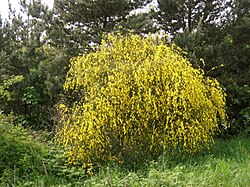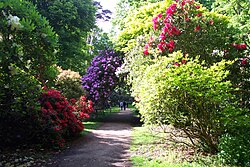
Back Struik Afrikaans ቁጥቋጦ Amharic Arbusto AN جنيبة Arabic Arbustu AST Kol Azerbaijani Ҡыуаҡ Bashkir Staud BAR Krūms BAT-SMG Куст Byelorussian
This article needs additional citations for verification. (October 2018) |


A shrub or bush is a small-to-medium-sized perennial woody plant. Unlike herbaceous plants, shrubs have persistent woody stems above the ground. Shrubs can be either deciduous or evergreen. They are distinguished from trees by their multiple stems and shorter height, less than 6–10 m (20–33 ft) tall.[1][2] Small shrubs, less than 2 m (6.6 ft) tall are sometimes termed as subshrubs. Many botanical groups have species that are shrubs, and others that are trees and herbaceous plants instead.
Some define a shrub as less than 6 m (20 ft) and a tree as over 6 m. Others use 10 m (33 ft) as the cutoff point for classification.[2] Many trees do not reach this mature height because of hostile, less than ideal growing conditions, and resemble shrub-sized plants. Others in such species have the potential to grow taller in ideal conditions. For longevity, most shrubs are classified between perennials and trees. Some only last about five years in good conditions. Others, usually larger and more woody, live beyond 70. On average, they die after eight years.[3]
Shrubland is the natural landscape dominated by various shrubs; there are many distinct types around the world, including fynbos, maquis, shrub-steppe, shrub swamp and moorland. In gardens and parks, an area largely dedicated to shrubs (now somewhat less fashionable than a century ago) is called a shrubbery, shrub border or shrub garden. There are many garden cultivars of shrubs, bred for flowering, for example rhododendrons, and sometimes even leaf colour or shape.
Compared to trees and herbaceous plants, a small number of shrubs have culinary usage.[citation needed] Apart from the several berry-bearing species (using the culinary rather than botanical definition), few are eaten directly, and they are generally too small for much timber use unlike trees. Those that are used include several perfumed species such as lavender and rose, and a wide range of plants with medicinal uses. Tea and coffee are on the tree-shrub boundary;[4] they are normally harvested from shrub-sized plants, but these would be large enough to become small trees if left to grow instead.
- ^ Lawrence, Anna; Hawthorne, William (2006). Plant Identification: Creating User-friendly Field Guides for Biodiversity Management. Routledge. pp. 138–. ISBN 978-1-84407-079-4.
- ^ a b Allaby, Michael (2019). A dictionary of plant sciences. Oxford Oxford University Press. ISBN 9780198833338. OCLC 1097073225.
- ^ "Life Spans of Small Trees and Shrubs". McCabe's Landscape Construction. 2014-02-27. Retrieved 2022-04-29.
- ^ Clayton, Liz (20 October 2021). "Is The Coffee Plant A Tree, Bush, Or Shrub?". sprudge.com. Retrieved 2022-04-29.